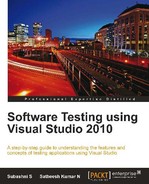Book Description
A step by step guide to understand the features and concepts of testing applications using Visual Studio.
Master all the new tools and techniques in Visual Studio 2010 and the Team Foundation Server for testing applications
Customize reports with Team foundation server.
Get to grips with the new Test Manager tool for maintaining Test cases
Take full advantage of new Visual Studio features for testing an application's User Interface
Packed with real world examples and step by step instructions to get you up and running with application testing
In Detail
When testing your applications on the Microsoft platform, Visual Studio 2010 offers you a range of powerful tools for different types of testing. This Microsoft product makes the testing process easier and faster.
A concise guide that will lead you through the amazing range of features offered by Visual Studio 2010 to test your software applications before going live. It is packed with simple but interesting examples to make you comfortable with Visual Studio 2010 testing environment. The book introduces you to the main types of testing available in Visual Studio for both desktop and web applications, and then walks you through deploying, running, and interpreting the results of tests.
Visual Studio 2010 is the new version of Microsoft's software development product, and includes lots of new features for developing and testing software applications. In collaboration with Team Foundation Server, it provides supporting tools for the management of the entire application life cycle, including development and testing.
This book is more focused on testing features and the supporting tools provided by Visual Studio 2010 for testing the applications.
The book begins by explaining different types of tests as part of the software development cycle, and then dives deep into providing an overview of each type of application testing using Visual Studio 2010 features. Along the way you will also learn in detail about creating and maintaining the test cases and associating the test cases with requirements using the Test Manager Tool.
Each chapter in the book concentrates on explaining each test type using the features and tools provided by Visual Studio 2010. You will be guided in using these features with real world examples with step by step explanations.
Get to grips with the amazing range of features offered by the Visual Studio for testing your software applications before going live.
Table of Contents
- Software Testing using Visual Studio 2010
- Table of Contents
- Copyright
- Credits
- About the Authors
- About the Reviewers
- Preface
- 1. Visual Studio 2010 Test Types
- 2. Test Plan, Test Suite, and Manual Testing
- 3. Automated Tests
- 4. Unit Testing
- Creating unit tests
- Assert statements
- Types of asserts
- Assert
- StringAsserts
- CollectionAssert
- CollectionAssert.AllItemsAreNotNull
- CollectionAssert.AreEquivalent
- CollectionAssert.AreNotEquivalent
- CollectionAssert.AllItemsAreInstancesOfType
- CollectionAssert.IsSubsetOf
- CollectionAssert.IsNotSubsetOf
- CollectionAssert.AllItemsAreUnique
- CollectionAssert.Contains
- CollectionAssert.DoesNotContain
- CollectionAssert.AreEqual
- CollectionAssert.AreNotEqual
- AssertFailedException
- UnitTestAssertionException
- ExpectedExceptionAttribute
- Types of asserts
- Unit tests and generics
- Data-driven unit testing
- Unit testing an ASP.NET application
- Unit testing web services
- Code coverage unit test
- Summary
- 5. Web Performance Testing
- 6. Advanced Web Testing
- 7. Load Testing
- 8. Ordered and Generic Tests
- 9. Managing and Configuring a Test
- 10. Command Line
- 11. Working with Test Results
- 12. Reporting
- 13. Test and Lab Center
- Index
